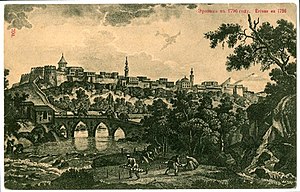Erivan Fortress
| Erivan Fortress | |
|---|---|
| Left bank of Hrazdan River (in the place of Ararat Wine Factory) |
|

View of Erivan in 1796 by G. Sergeevich.
|
|
| Coordinates | 40°10′23″N 44°30′10″E / 40.173056°N 44.502778°E |
| Site information | |
| Condition | Demolished |
| Site history | |
| Built | 1582–83 |
| In use |
Erivan Sardars' seat (until 1827) Armenian Oblast Governor's(1828–40) Erivan Governorate's Governor (1850–64) |
| Demolished | 1860s–1930s |
| Battles/wars |
Turkish-Persian War, 1623-39 Turkish-Persian War, 1722-27 Turkish-Persian War, 1730-36 Russo-Persian War, 1826-28 |
Erivan Fortress (Armenian: Երևանի բերդը; Yerevani berdë; Persian: قلعه ایروان, Ghaleh-ye Iravân; Azerbaijani: İrəvan qalası – ايروان قالاسى; Russian: Эриванская крепость E'rivanskaya krepost' ) was a 16th-century fortress in Yerevan.
The fortress was built during the Ottoman rule in 1582–83 by Serdar Ferhat Pasha. The fortress was destroyed by an earthquake in 1679. After the earthquake, the Safavid governor of Erivan, Zal Khan, asked the Shah for help to rebuild Erivan, including the fortress and the Palace of the Sardars.
On 12 July 1679, the Safavid vice-regent of Azerbaijan (historic Azerbaijan, also known as Iranian Azerbaijan), Mirza Ibrahim, visited Erivan. He was directed to recover the fortress, the seat of the governor of Erivan. Many villagers from Ganja, Agulis and Dasht (Nakhchivan) were moved to Erivan to rebuild the fortress. The forced labor continued until winter. Later, the Shah allowed everyone to return to their homes. The reconstruction of the Erivan Fortress was not finished. It was continued and finished in the following years. In October 1827, during the Russo-Persian War of 1826–1829, the Russian army by the leadership of Ivan Paskevich captured Erivan and the Erivan Fortress was not used for military purposes since then, until its complete destruction in 1930s.
In 1853, the fortress was ruined by another earthquake. In 1865 the territory of the fortress was purchased by Nerses Tairyants, a merchant of the first guild. Later in 1880s, Tairyants built a brandy factory in the northern part of the fortress. The fortress was completely demolished in 1930s during the Soviet rule, although some parts of the defensive walls still remain.
...
Wikipedia
